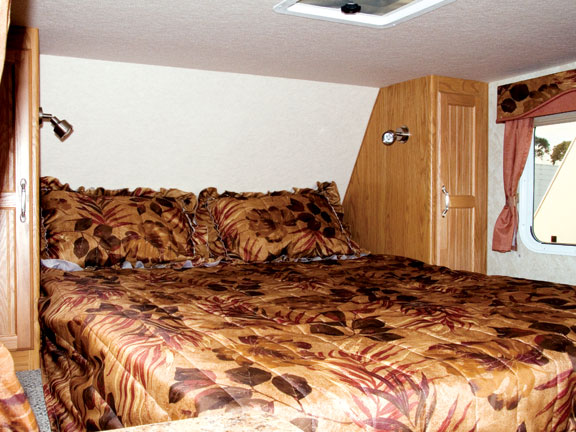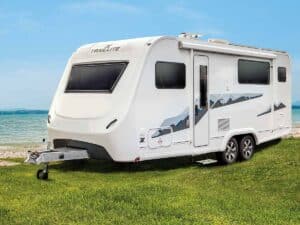I once asked a Canadian, “What makes you different from Americans?” Without hesitation he replied, “We are more pragmatic and prefer simple solutions.”
The Okanagan range of fifth wheels reflects this Canadian trait. Externally, the rectangular shape, flat sides, roof and rear panel are rescued from being boring by the balanced proportions of the overall design.
At 2.9 metres, it is not too high. The pair of alloy wheels located amid-ships provide a focus point, blending into the alloy skirt and coloured side stripes that embellish the bottom of the side panel. The discreetly angled nose panel completes this no-nonsense design. The window frames are colour coded to match the body panels, and the furled 4.8-metre Colorado awning aligns perfectly with the RV roofline. The resulting appearance is compact, balanced and uncluttered.
Okanagans are imported by the New Zealand agents, North Shore Caravans Ltd. They are built in Canada to specifications designed to comply with New Zealand regulations and preferences. The access door is on our ‘kerb’ side. The 230-volt electrics meet the updated New Zealand electrical WOF requirements. The gas reticulation and appliances are of specifications suitable for LPG supplied in New Zealand. All models they import are New Zealand self-containment compliant ex-factory.
Massaging the product to suit New Zealanders did not happen overnight. At first the Canadians were reluctant to change. But over the eight years Rob Griffith has been importing Okanagans, he has become a valued client and they are happy to adapt the product. This past season Rob has introduced more than 35 Kiwis to the pleasures of Okanagan fifth wheels.
There are two aspects of the Okanagan in particular that draw prospective buyers to the range: the gross vehicle weight allows them to be towed by Japanese utes like the Hilux and Navarra, and the price compares well with caravans of similar length.
I watched a couple putting the Eclipse ECL25-5SL to the test. While Rob was explaining the mechanics of the tow-hitch to the husband, I asked his wife if they were buying the Eclipse. “Oh yes,” she said, “I think so.”
“Have you had an RV before?”
“We’ve had two,” she said. “Both buses my husband converted to motorhomes. This time we are getting a finished RV. In the Okanagan we like the permanent double bed and the entertainment lounge. Most motorhomes with this combination in our price range only offer a double bed over the cab. The Okanagan also has a slide-out, which gives us even more living space. If we sell our car and put the money towards a Navarra, we can have the best of both worlds.”
The Eclipse is a compact 2.28 metres wide. The lounge dinette is at the rear, a bathroom/toilet opposite the access door, the kitchen unit between the access door and dinette, and storage unit and fridge/freezer opposite the kitchen. The fridge/freezer and settee are located in the slide-out section.
The settee, which is also a pullout (large single) bed, is well sprung and upholstered. Opposite is the dinette, which seats four comfortably. The sliding window beside the table affords a good view outside, and like most of the other windows in the Eclipse, the window has a neat fabric concertina blind with a positive pull-down/push-up action.
The freestanding, stable dinette table has folding legs, which allows the tabletop to form a base for a second small double or large single bed. There’s ample storage space under the dinette seats and in the overhead lockers. The Jensen entertainment centre (radio, CD/DVD/MP3 player) is conveniently located in the locker above the dinette.
Having the large Dometic 186-litre fridge/freezer located in the slide-out creates more space in the kitchen area. The floor to ceiling pullout pantry is close at hand in the storage unit beside the fridge. The bench can cope with at least four dining plates at a time, and the large double sink will make short work of the washing-up. A Smev three-burner hob in the bench top is above a Smev oven/grill unit, with a fan-assisted range hood to clear the air. There is also a fan vent in the ceiling.
You won’t go short of 230-volt power as there are four power-points; two under the overhead locker, and two on the bench cabinet. The large drawers and cupboards with big doors under the bench provide easy access to the storage space.
The toilet/bathroom set-up is different from most seen in New Zealand. Instead of a shower tray there is a ‘step-tub’ – a shower in a tub, enclosed with a shower curtain, which keeps the water off the floor and is convenient for washing feet and small items, but not so useful as standing space for getting dressed. The waste and fresh water tank monitor is mounted on the wall at eye level opposite the toilet – a classic example of Canadian pragmatism. The hand-basin has a faucet tap fitting that also controls a separate shower handpiece. Behind the hand-basin is a large wall mirror with a ceiling light above to augment the natural light from the fan-assisted hatch vent in the roof. It is a practical, roomy bathroom.
The bedroom doesn’t have full headroom – this may be a downside for some. The permanent island queen-size bed is located above the tow-hitch. But the bed is easily accessed. There is ample headroom to sit up in bed and the generously inner-sprung mattress is comfortable. Each side has a reading light and a hanging locker. Two sliding windows and a roof hatch provide light and air. The bed lifts, gas strut assisted, to access shallow storage 100mm deep, the full size of the bed.
The interior of the Eclipse is typically North American, with cabinetry of solid oak appearance and conservative autumn tone fabrics. Having become accustomed to the ‘European style’ that prevails in the New Zealand market, my initial reaction was, “This is not what I would choose”. However, after a while it grew on me. The fabrics are good quality and hard wearing, and the solid timber doorframes and the build of the cabinets suggests they will be around for a while.
Backing the Navarra up to connect the Eclipse was easy as the hitch point is clearly visible at eye level through the cab rear window. Then it was just a matter of pushing the switch to wind in the slide-out and hand cranking up the steadying jacks on the front of the Eclipse.
A short drive through the hilly part of the North Shore bays showed the diesel turbo-engined Navarra quite capably handled the load of the Eclipse. The only problem I had was forgetting I had the Eclipse behind me and upsetting a fellow motorist at a roundabout. The Navarra was quite at home at motorway speeds on the return journey. The electric brake controller supplied with the Eclipse is impressively effective and easy to use, allowing the driver to adjust the brakes to cope with all conditions, from city driving to going down the steep slopes of the Haast Pass.
Standard fittings
- The fifth wheel hitch and an electric brake controller
- The rear bumper can be extended rearwards for mounting a storage box
- Connection to mains water pressure
- Fire extinguisher
- CO²/LPG/smoke detector
- Wind-up Winegard TV aerial
- 2 x 9kg gas cylinders
- 3.6kW gas heating
- Exterior shower
- Heavy-duty alloy wheels suitable for dual axle use









